Scientists Link Climate & Weather — Journalists Should As Well

Originally published on Nexus Media.
By Jeremy Deaton
We used to say that global warming was like the steroid era in baseball: You couldn’t say that any single hit was the product of steroids, but the home-run boom looked awfully suspicious.
Likewise, the surge in extreme weather lined up neatly with the rise in carbon pollution, even if people couldn’t say that any one flood or heat wave was the product of human activity — at least, that’s how experts used to explain it.
In the last decade, though, scientists have gotten really good at discerning the human fingerprint on extreme weather events. To extend the metaphor, we can now look at a home run and say how many extra feet it traveled due to steroid use.
Reporters, however, have yet to catch up. Many consistently fail to draw the line between climate change and extreme weather.
Last month, experts published a new article in the World Meteorological Organization Bulletin calling on journalists — including general reporters as well as weather forecasters and meteorologists — to connect the dots.
“The media, politicians, and some scientists outside this area of research still often claim that ‘we can’t attribute any individual event to climate change.’ This may have been true in the 1990s, but it is no longer the case,” the article says. It also tells scientists how to “effectively and accurately communicate the role of climate change” when talking to the press.
Scientists have gotten really good at attribution.
The science of attributing extreme weather to climate change dates back to a 2004 study showing that global warming doubled the odds of the 2003 European heat wave.
The science has evolved to the point that, earlier this year, researchers determined the number of people killed by climate change during that same heat wave.
“Thanks in part to better data and higher resolution climate models, we are developing the tools to assess not only global warming’s role in changing weather risk but also its role in actual damages,” said Heidi Cullen, chief scientist at Climate Central.
Why have scientists gotten so much better at attribution?
- Weirder weather. One reason it’s getting easier to tease the signal from the noise is that we are seeing a lot more signal. Case in point: Since 2010, the United States has seen nine rainstorms of the kind predicted to occur only once every 1,000 years.
- Better data. Researchers have assembled more robust data on weather and climate from more sophisticated measuring equipment.
- Faster computers. More powerful computers have allowed scientists to run more refined computer models over shorter periods of time. Now, researchers can find the climate signal in storms, heat waves, droughts, and floods much more quickly.

Better climate models are key. To fully understand the effect of burning fossil fuels, we would need a second Earth unblemished by carbon pollution. Since we’re stuck with just the one, scientists use computer models to understand the influence of heat-trapping gasses and project how they will shape the climate in the years ahead.
“Since the human influence on climate is well established, and all events take place in that changed environment,” the WMO article notes, “the question should no longer be ‘is there a human component,’ but ‘what is it?’”
To see how this works in practice, here are a few examples from the literature:
- Superstorm Sandy. Over the last century, New York has seen around one foot of sea-level rise. This extended the reach of floods during Superstorm Sandy. Scientists measured sea-level rise and accounted for its influence on flooding.
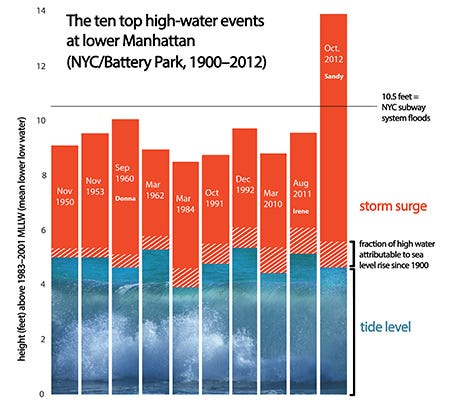
- California’s drought. A 2015 paper found that 15 to 25 percent of the severity of the California drought can be explained by climate change. Hotter weather robs soil of its moisture, exacerbating the dry spell. Scientists gauged the increase in temperature to determine the effect of global warming.
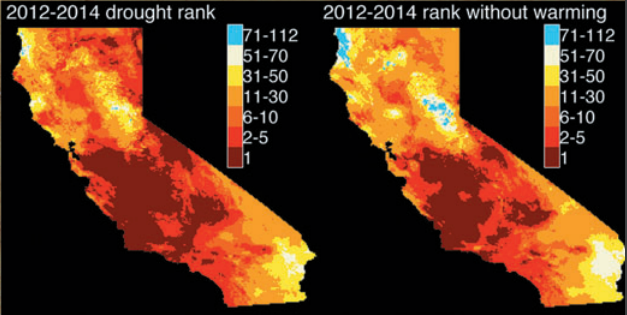
- Louisiana floods. To offer a more recent example, climate change upped the odds of August’s torrential rainfall in Louisiana by 40 percent. By comparing historical weather patterns to today’s storms, researchers were able to deduce the role of climate change.
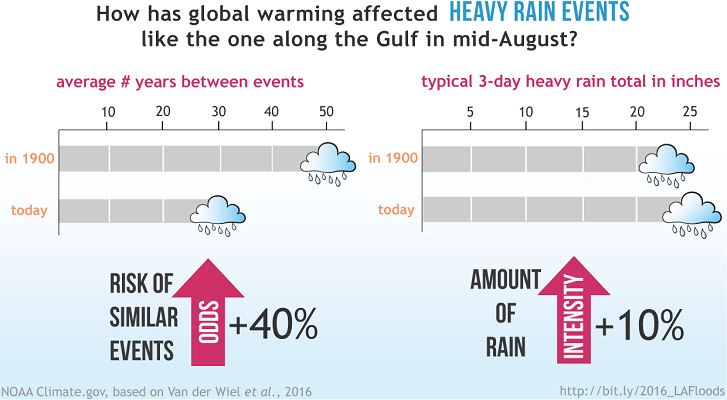
These are just a few examples. You can find more here and here. The point is that attribution science has come a long way. As the WMO article argues, scientists should explain the link between climate and weather, and reporters should take note.
Reporters routinely fail to link climate and weather.
Despite the wealth of attribution research, reporters frequently fail to draw the line between weather and climate. Media Matters reported that nightly newscasts all but ignored the influence of climate change on torrential rainfall in Louisiana and floods in Texas this summer.
You can find a particularly stark example of the missed connection in newspaper coverage of EPA’s Clean Power Plan that ran alongside stories of wildfires in California. Several reporters overlooked the well-documented influence of climate change on the fires.
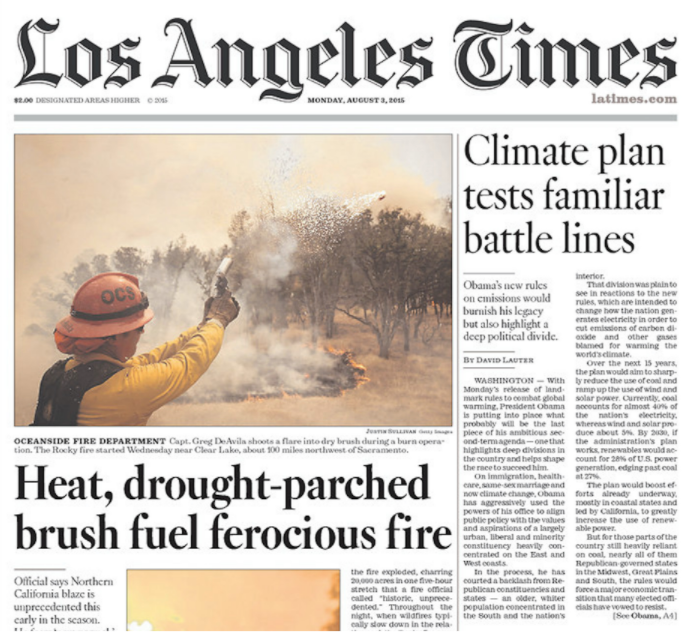
This is important because, generally speaking, climate change doesn’t get nearly enough coverage. In 2015, broadcast news covered climate change less than Deflategate.
The central challenge is that news outlets report on events. They tell the public what’s happening today. For global warming to penetrate the public consciousness, reporters need to link the news — storms, fires, and floods — to the cause, carbon pollution. Without that link, climate doesn’t make it into the conversation.
The WMO article makes this point emphatically: “Changes in extreme weather and climate events are the primary way that most people experience climate change,” authors write. “There is a clear opportunity for the media to discuss the most visible impacts of climate change in their coverage of weather disasters, though it is an opportunity that is missed far too often.”
Americans trust weather reporters for information about climate change.
Weather reporters, particularly TV meteorologists, are well positioned to talk about global warming. When it comes to climate, Americans trust weather forecasters more than the pope, the president, or the mainstream press. A 2015 study found that people who paid attention to weather forecasts tended to be more concerned about climate change.
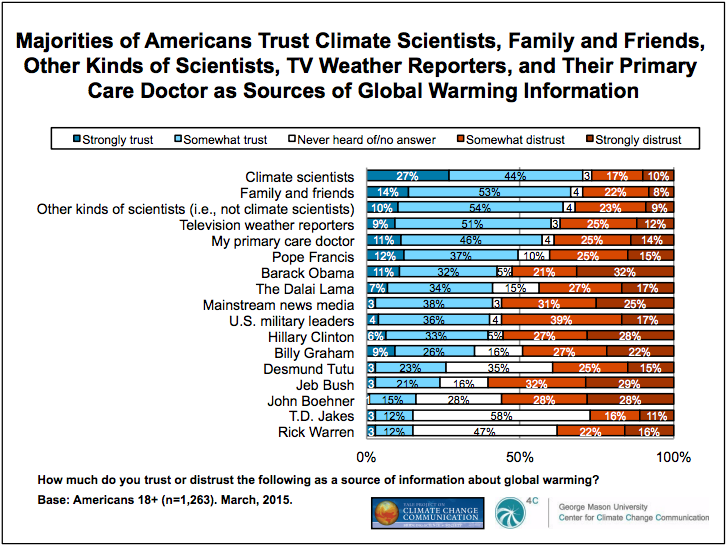
To be fair, a shift is already underway among TV meteorologists. More and more acknowledge that the climate is changing. Some, like Miami’s John Morales, are calling for their colleagues to link climate and weather.
Others with a bullhorn in South Florida should have the courage to discuss #sealevelrise on air & online like I’ve been for years (6/6) Sigh
— John Morales (@JohnMoralesNBC6) October 18, 2016
But more journalists need to follow suit and report on the carbon pollution. And there are a number of resources to help them, including the World Weather Attribution project and Climate Signals. [Disclosure: Climate Signals and Nexus Media are both sponsored projects of Rockefeller Philanthropy Advisors.]
Climate change is the new normal.
The WMO article doesn’t cover a lot of new territory, but it is notable for its source. Unlike the WMO Bulletin’s usual fare of weather and policy wonkery, this article reads like a plea to reporters and researchers.
“It was the WMO leadership that asked me and a few of their other advisors to write this article because they felt that, worldwide, there was a lot of confusion — not just among journalists and the lay public, but even among some scientists, even among meteorologists who deal with these issues,” said Susan Joy Hassol, director of Climate Communication and lead author on the article.
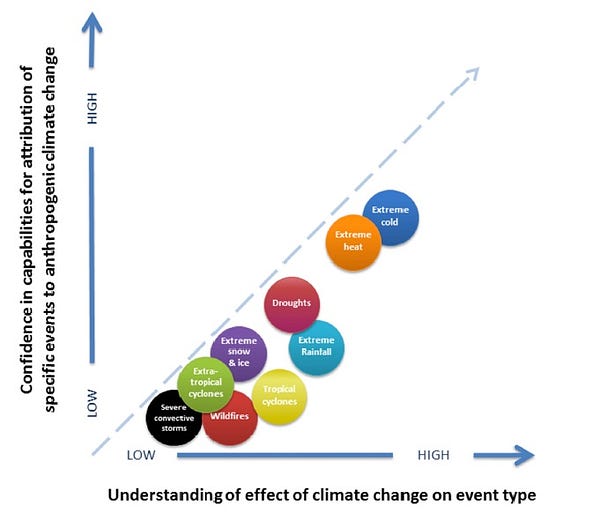
“We continue to hear people repeat things like, ‘We can’t attribute any particular event to climate change,’ even though that’s no longer true,” she said.
People have historically treated the climate link as a binary condition, Hassol said. Either a storm was the product of carbon pollution or it wasn’t. She warns against looking for a single cause.
“Any weather event is taking place in a changed environment because of human-caused climate change,” said Hassol.
Climate change is more than just a few extra home runs. It’s a whole new ball game. Warmer waters, higher sea levels, and more atmospheric moisture have shifted weather patterns across the globe.

It’s the job of scientists to understand how climate change is fueling extreme weather. It’s the job of reporters to share that information with the public.
“People don’t realize that these extreme weather events… are being affected by climate change,” said Hassol. “Climate change is not just a distant problem for the future. It’s affecting them now in their lives.”
Reprinted with permission.

Sign up for CleanTechnica's Weekly Substack for Zach and Scott's in-depth analyses and high level summaries, sign up for our daily newsletter, and follow us on Google News!
Whether you have solar power or not, please complete our latest solar power survey.
Have a tip for CleanTechnica? Want to advertise? Want to suggest a guest for our CleanTech Talk podcast? Contact us here.
Sign up for our daily newsletter for 15 new cleantech stories a day. Or sign up for our weekly one on top stories of the week if daily is too frequent.
CleanTechnica uses affiliate links. See our policy here.
CleanTechnica's Comment Policy
